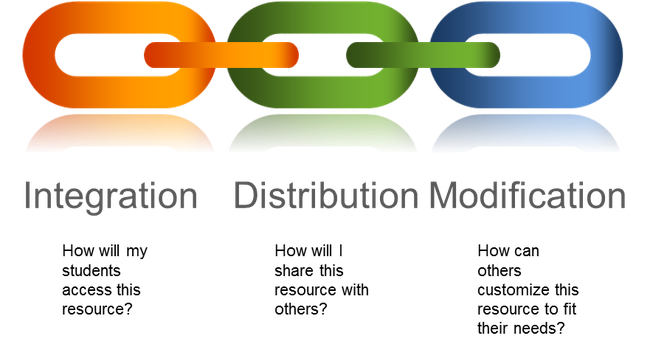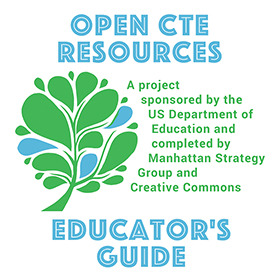Open CTE Resources: Educator's Guide
Your learning needs will determine what kind of OER suits you and your students best, and therefore what type you might choose to reuse, remix, or build yourself. It is recommended that anyone interested in using or creating OER comprehensively assess their needs prior to adoption, as the section below is designed to assist you in doing.
Content: What Is My Desired Learning Outcome?
For CTE educators, assessing learning outcomes will likely center around required skill sets. Key questions include:
- What skills do my students need to learn?
- What will most help them to be successful?
- What are they currently struggling to understand?
The Common Core vs. Industry-Specific Skills
CTE educators are in the challenging position of having to balance an evolving general framework for academic success with the growing demands of their particular industry. The Common Core will apply to educators in most states and within industries. Multiple frameworks have been developed to guide instruction and to assess competency. It is recommended that you have an understanding of what is expected in both spheres. The OER that best meets your needs might address one or both of these requirements.
Flash Forward: Using OER to Align to the Common Core
An open educational resource effectively aligns to the Common Core only when it is clear what standard it is supporting.[6] One way of communicating this is by directly stating it on the resource itself. Another way to is to tag the resource with the appropriate metadata, although this is only effective if the tagging is done in a methodical, standardized way. A search engine (including comprehensives applications such as Google or those specific to OER such as the OER Commons) cannot recognize what Common Core standards are being supported if each resource tags it in a unique manner. It is important to note that Common Core standards were developed and named specifically with these requirements in mind. For more information on how to appropriately identify and tag a Common Core aligned resource, visit Common Core State Standards for Developers and Publishers.
Career-Focused Skills Frameworks
Employability Skills
The Employability Skills Framework, developed by the US Department of Education Office of Career Technical and Adult Education (OCTAE), is intended to advance a “unifying framework that cuts across the workforce development and education sectors.” It was developed in collaboration with CTE, adult education, workforce development, and business organizations. The Framework website acts as a central clearinghouse of resources on instruction and assessment for employability skills, and through its tools, educators can identify and compare various employability skills, understand the selection of an appropriate employability skills assessment, and view practical examples of employability skills instruction and assessment.
Common Career Technical Core
The Common Career Technical Core (CCTC) is a set of benchmark standards for CTE, published by the National Association of State Directors of Career Technical Education (NASDCTE). According to its authors, “the goal of the CCTC is to provide students with the knowledge and skills needed to thrive in a global economy.” The CCTC includes a set of standards for each of the 16 Career Clusters® and their 79 Career Pathways, as well as a general set of Career Ready Practices.
21st Century Skills
For new programs or courses for which learning outcomes are undefined, 21st century skills are a good place to begin. EdGlossary defines 21st Century Skills as “a broad set of knowledge, skills, work habits, and character traits that are believed—by educators, school reformers, college professors, employers, and others—to be critically important to success in today’s world, particularly in collegiate programs and contemporary careers and workplaces.” They are increasingly aligned with the objectives of today’s CTE programs. Resources include:
- P21 Resources for Educators: According to Partnership for 21st Century Skills, the P21 framework “presents a holistic view of 21st century teaching and learning to help students master the multi-dimensional abilities required of them in the 21st century and beyond.”
- “21st Century Skills”: A wealth of information provided by ED Glossary that both defines 21st Century Skills and links to appropriate instructional frameworks
- “Employability/21st Century Skills”: A comprehensive list of articles, briefs, reports, videos, and research to help keep you up to date on the latest findings
Department of Labor “Competency Models”
The US Department of Labor offers industry-validated competency models and tools to build your own. A competency is the capability to apply a set of related knowledge, skills, and abilities to successfully perform functions or tasks in a defined work setting. These models can be used to build practical guidelines for learning objectives.
The Value of Community Partnerships
Another effective means of determining industry-specific skills is to “go straight to the source” and explore local employer partnerships. Several Trade Adjustment Assistance Community College and Career Training (TAACCCT) grantees, composed of STEM-focused instructors, curriculum designers, and programmers, found that employer input was critical to developing highly relevant OER. For example, the National STEM Consortium based in Arnold, Maryland partnered with local defense contractor ARINC to brainstorm the workplace skills that became the learning outcomes of their “STEM Foundations” course for their adult education cohort program.
Network
The following resources, which were selected for their applicability to a wide range of educators, can help you to network and explore community partnerships in your area:
- “Building Community Partnerships: Resource Roundup”: Tools, techniques, and sample partnerships to inspire and implement.
- “Workforce System Contacts - Workforce Investment Boards”: Contact your local Workforce Investment Board about facilitating a partnership between your school and a local business.
Context: Where Will This Content Go?
It is also important to consider where OER will fit into your instructional model. You might use OER to address a particular gap in the curriculum or you might use it to supplant a traditional textbook entirely. Your technical considerations will largely be dependent upon why students access the content and where the access takes place.
Key questions include:
- Will you use a Learning Management System (LMS) to structure your course?
- Will your students interact with the content at home or in-class?
- Will you supervise their interaction or will they complete it independently?
- What type of technology is available in the classroom (projector, speakers, clicker, etc.)?
Case Study: OER and Flipping Your Classroom
One relevant example of flipping the classroom using Open Educational Resources is currently being implemented by Liberty High School in Eldersburg, Maryland. “Flipping the classroom” is a school managed instructional technique in which students teach and switch roles with teachers. They also learn content online by watching video lectures, usually at home. What used to be homework (assigned problems) is instead completed in class with teachers and students discussing and solving questions. This allows for more personalized guidance and interaction with students, instead of static lecturing.
In Liberty’s case, a specialized independent study program has been developed to supplement traditional classroom offerings. Through an application process that is open to seniors only, students select a course from the MIT OpenCourseWare repository. The students, either individually or in small teams, complete the course over nine weeks. Halfway through the nine weeks, they begin research projects of their own design.
Sample independent study topics using these OER have included Nutrition & School Lunch, Cancer Research, Psychology of Happiness, Economics (Maryland minimum wage law), Theatrical Design, Game Design R&D, and Early Childhood Education. The projects have also been used as “capstone” following completion of a local CTE certification.
What If I Need to Track Student Progress in a Resource, but I Don’t Have an LMS?
If your school does not offer LMS access and you think that student track would add considerable value to your resource of choice, it is helpful to note that many open online courses offer LMS functionality within their internal platform. This often means that students will be required to log-in using a special course key. Instructors will be able to monitor progress and assessment outcomes. In addition, consider exploring the many free open source LMS platforms. While your course site will still require web hosting, many non-profits offer free hosting for educators. Free LMS options include:
- Moodle
- ILIAS
- Blackboard CourseSites
- Iteach.org (free web hosting for educators)
Construction: What Format Will This Context Support?
The construction of OER will be highly determined by the context in which they are presented. There are many types of content that can only be accessed by having an account with the developing site, which may not be practical for your students to access outside of the classroom. Other types of content may require particular browser versions and plug-ins to operate. In addition to access, you will have to consider what adjustments you might like to make to any existing OER. Remixing may require separate software or programming skills. The following will help you assess existing resources or tools that help you create resources.
In using or developing OER, examination from multiple perspectives is key to choosing an appropriate approach. It is helpful to “put yourself in the shoes” of several types of potential users to determine not only whether a particular type of OER meets your needs, but if it will tool or meet their needs as well. An OER is only as effective as the goals it accomplishes.
The OER Chain

The OER creation process is a complex one, with many choices to consider along the way. The components of high quality OER can be thought of as a chain, where each link is subject to breaking when care is not taken. A broken chain is not useless. In some cases, it might even be the right tool for the job. But in some cases, it may be of less utility than an unbroken chain. We will consider each of these “links” in turn.
Integration
This link considers how an OER will fit into your classroom. We have already discussed two factors of that analysis – learning objective and pedagogical context (assignment, lecture, project, etc.) – and this component simply requires you to take the next step of deciding whether or not a particular method or tool will meet your needs. Largely, this comes down to output: Is the file type one that can be accessed by both me and my students with little difficulty? It is also important to consider your intended pedagogical use. You need to understand if you will require features such as student tracking or embedded assessment.
Distribution
Distribution represents another layer of determining OER utility. Understanding how community members will locate a resource is critical to ensuring that they will, in fact, find it. In order for an OER to be found by others not directly in your network, it will have to be hosted on a web server. In some cases, it will be hosted by the OER repository in which you list it. In others, you will have to create and host a web page particularly for this purpose.
Modification
No learning resource suits every educator, and thus modification is a highly desirable quality in an OER. However, simply because a resource cannot be customized does not mean it is of little value. Modification is not possible with many outputs, but it is important to note that it is not always necessary. While it may be difficult to modify a SCORM package in its original format, it may be completely sufficient to do away with a few modules in implementation. Similarly, while it may be impossible to “modify” a simulation created in a proprietary application, the experience of the simulation will be customized to each student based upon their choice and reactions.
